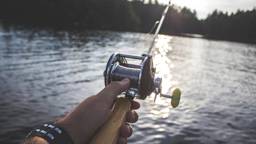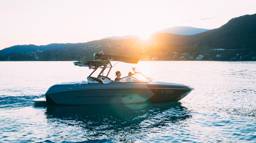Should you replace your tired outboard with a newer model or rebuild that boat motor?
Story & photos by John Tiger

You’ve owned your outboard-powered “cottage craft” for many years. Maybe it’s a pontoon with a midsized 70-horsepower motor, an aluminum fishing skiff with a kicker, or even a runabout with a larger V-6. Whatever your pleasure, boaters are eventually faced with a decision about their aging outboard motor: Rebuild or open the checkbook and buy brand new? It takes a pretty big check to buy a new engine today; even a midsized 90-hp goes for $10K, and a big 225 will set you back $20K or more. Repairing what you have, or buying a used engine and having it rebuilt, can be reasonable alternatives. However, there’s more to it than the initial cash outlay. Newer outboards – those built in the 21st century, and especially in the past 10 years – have improved pretty dramatically. These outboards have much more sophisticated fuel-management and ignition-timing systems, and like today’s cars, use much less fuel and pollute significantly less. Besides the fuel economy and emissions improvements, the most noticeable improvements for the boater include dramatically easier starting and improved running quality. In the end, the bottom line is – are they worth their price tag, especially for a “toy” that likely gets used less than one total month per year? Or put another way, can you justify dropping upwards of $10k on an engine that will sit quietly, unused, for three-quarters of the year?
 How old is old?
How old is old?
Your outboard, depending on its age and horsepower size, may be “ancient,” or it may already have most of today’s engine features and benefits. If yours was built in the ’80s or later, chances are it has:
- No overboard fuel drains – No overboard fuel drains: These were eliminated with the 1972 models. Prior to that, unburned fuel that never made it into the engine was simply drained into the water. Very bad for the environment, and bound to make you unpopular at the launch ramp, as your engine leaves rainbows of fuel/oil in the water as you idle away from the dock!
- Power trim and tilt – Very handy for skiing, fishing, and even docking and storage. Electronic oil injection – Makes for much easier fuel-ups, and pollutes far less than premixing gas and oil.
- Primer starting vs. chokes – An electric primer shoots fuel into the carburetors, making cold starts much quicker and easier.
- Sound-deadened cowl exhaust – Outboards built in the 1970s and prior were much louder.
- Electronic fuel injection – EFI became more popular starting in the late 1980s; it makes an outboard easier to start and run, less smoky and better on fuel, as well as just a bit better than a carbureted engine when it comes to pollution.

If your engine has some or all of these features, then there are still a few significant advantages that buying a brand-new engine could give you. Why? Outboard manufacturers have been forced by the EPA to build and sell engines that pollute less. As a result, since the late 1990s most outboards have either been of the four-stroke variety (like your car), or a newer technology called DFI two stroke – direct fuel injection adapted to traditional two-stroke outboard engines. Outboards have for over a century largely used the two-stroke design. Like traditional two strokes, these newer DFI engines use an oil-burning two-stroke design, but they inject the fuel/air and oil charge directly into the cylinder with such high precision and timing that the result is a dramatic drop in emissions, and an equally dramatic rise in fuel economy, as well as less oil use. The latest (built after 2004) DFI two strokes perform as well or better than the best four strokes, with very comparable fuel economy and emissions numbers as well. Lastly, the ease of operation is unparalleled by any older traditional carbureted two-stroke engine. What’s that all mean to you, the boater? Simply, today’s four-stroke and DFI two-stroke outboards: Burn between 35% and 50% less fuel than their older carbureted brothers. Reduce emissions pollution by an equal amount. Display starting ease, running quality, and noise levels much like a newer car.
 Cost differences
Cost differences
It helps to take a look at what buying a new motor costs as compared to simply repairing or rebuilding what you have. A typical new midsized outboard (90 to 115 hp) will cost you at least $9K if purchased from a discount dealer, and more like $10K+ if purchased from a local full-service dealer. Rebuilding an older engine of the same size might cost about $3.5K or so – or about a third of the cost of a new engine. That $5K (or more) difference will buy a lot of gas, so consider carefully.
What’s the right answer?
There’s a lot to consider, a lot at stake. Money, family time, environmental consciousness – these are all valid concerns. Your budget may not permit buying a new outboard. In that case, rebuilding what you have may be your only course. If you’re concerned about reducing emissions and aquatic pollution, a new DFI two-stroke or four-stroke engine, despite the high initial cost, may be for you.
- Regardless of how much you use the engine, the initial cost differences between buying new and repairing old are so large that “potential fuel savings” with a new engine – no matter how seemingly attractive – will be negligible in the long run, especially as of this writing when fuel prices are at record lows. So, this consideration should be low on your list, unless fuel prices rise dramatically.
- Consider your local dealer and his availability, and the time you actually have to use your boat. If you’re like most, you need that outboard to run properly, every time – family and friends want to have fun with it, usually now, not two weeks from now. In this case, a new engine may be a wise investment, because reliability is paramount. Though it’s not popular to say, you’re likely to get quicker service turnaround from your local dealer if you buy a new engine. If you’re thinking of saving a few bucks buying from a discount dealer, consider: Will you be happy about bringing your boat to that dealer for service if he’s hundreds of miles away? Will your local dealer be happy to service the motor if you didn’t buy it from him?
- If you’re considering rebuilding, talk to your local dealer. Get firm cost estimates, and ask about a warranty. If your engine was built prior to 1980 or so, forget it. It’s too old, parts likely are too scarce, and technology is way out of date. If it’s an ’80s engine with some or all of the features previously mentioned, and a new engine is out of the question, rebuilding is a good option that will add more years to your old outboard’s life.
- Lastly, if you’re thinking about buying used, be extremely careful. If you’re not an outboard expert who can completely check out potential engines (with diagnostic checks like compression testing, spark testing, etc.), then direct your purchase to a dealer who can give a guarantee with a used or rebuilt unit.
- Without this assurance, you are asking for trouble. Like cars, used engines can be cream puffs or piles of trouble. Even better would be to have a dealer rebuild a used engine for you; you’ll pay a bit more, but basically have a new engine at a fraction of the new price.
Finally, consider the “new-engine” factor – that is, there’s nothing quite like a new engine. It starts easier, runs nicer, idles better, and shifts more smoothly. For many, the “Wow, it’s new” factor is enough to head down to the dealer to check out the new motors.
John Tiger has spent his lifetime and career around outboards. He’s owned over 70 of them, repairs and rebuilds them as a sideline, has raced them since the early 1980s, and has worked at outboard dealerships.
 You’ve owned your outboard-powered “cottage craft” for many years. Maybe it’s a pontoon with a midsized 70-horsepower motor, an aluminum fishing skiff with a kicker, or even a runabout with a larger V-6. Whatever your pleasure, boaters are eventually faced with a decision about their aging outboard motor: Rebuild or open the checkbook and buy brand new? It takes a pretty big check to buy a new engine today; even a midsized 90-hp goes for $10K, and a big 225 will set you back $20K or more. Repairing what you have, or buying a used engine and having it rebuilt, can be reasonable alternatives. However, there’s more to it than the initial cash outlay. Newer outboards – those built in the 21st century, and especially in the past 10 years – have improved pretty dramatically. These outboards have much more sophisticated fuel-management and ignition-timing systems, and like today’s cars, use much less fuel and pollute significantly less. Besides the fuel economy and emissions improvements, the most noticeable improvements for the boater include dramatically easier starting and improved running quality. In the end, the bottom line is – are they worth their price tag, especially for a “toy” that likely gets used less than one total month per year? Or put another way, can you justify dropping upwards of $10k on an engine that will sit quietly, unused, for three-quarters of the year?
You’ve owned your outboard-powered “cottage craft” for many years. Maybe it’s a pontoon with a midsized 70-horsepower motor, an aluminum fishing skiff with a kicker, or even a runabout with a larger V-6. Whatever your pleasure, boaters are eventually faced with a decision about their aging outboard motor: Rebuild or open the checkbook and buy brand new? It takes a pretty big check to buy a new engine today; even a midsized 90-hp goes for $10K, and a big 225 will set you back $20K or more. Repairing what you have, or buying a used engine and having it rebuilt, can be reasonable alternatives. However, there’s more to it than the initial cash outlay. Newer outboards – those built in the 21st century, and especially in the past 10 years – have improved pretty dramatically. These outboards have much more sophisticated fuel-management and ignition-timing systems, and like today’s cars, use much less fuel and pollute significantly less. Besides the fuel economy and emissions improvements, the most noticeable improvements for the boater include dramatically easier starting and improved running quality. In the end, the bottom line is – are they worth their price tag, especially for a “toy” that likely gets used less than one total month per year? Or put another way, can you justify dropping upwards of $10k on an engine that will sit quietly, unused, for three-quarters of the year?
 How old is old?
How old is old? If your engine has some or all of these features, then there are still a few significant advantages that buying a brand-new engine could give you. Why? Outboard manufacturers have been forced by the EPA to build and sell engines that pollute less. As a result, since the late 1990s most outboards have either been of the four-stroke variety (like your car), or a newer technology called DFI two stroke – direct fuel injection adapted to traditional two-stroke outboard engines. Outboards have for over a century largely used the two-stroke design. Like traditional two strokes, these newer DFI engines use an oil-burning two-stroke design, but they inject the fuel/air and oil charge directly into the cylinder with such high precision and timing that the result is a dramatic drop in emissions, and an equally dramatic rise in fuel economy, as well as less oil use. The latest (built after 2004) DFI two strokes perform as well or better than the best four strokes, with very comparable fuel economy and emissions numbers as well. Lastly, the ease of operation is unparalleled by any older traditional carbureted two-stroke engine. What’s that all mean to you, the boater? Simply, today’s four-stroke and DFI two-stroke outboards: Burn between 35% and 50% less fuel than their older carbureted brothers. Reduce emissions pollution by an equal amount. Display starting ease, running quality, and noise levels much like a newer car.
If your engine has some or all of these features, then there are still a few significant advantages that buying a brand-new engine could give you. Why? Outboard manufacturers have been forced by the EPA to build and sell engines that pollute less. As a result, since the late 1990s most outboards have either been of the four-stroke variety (like your car), or a newer technology called DFI two stroke – direct fuel injection adapted to traditional two-stroke outboard engines. Outboards have for over a century largely used the two-stroke design. Like traditional two strokes, these newer DFI engines use an oil-burning two-stroke design, but they inject the fuel/air and oil charge directly into the cylinder with such high precision and timing that the result is a dramatic drop in emissions, and an equally dramatic rise in fuel economy, as well as less oil use. The latest (built after 2004) DFI two strokes perform as well or better than the best four strokes, with very comparable fuel economy and emissions numbers as well. Lastly, the ease of operation is unparalleled by any older traditional carbureted two-stroke engine. What’s that all mean to you, the boater? Simply, today’s four-stroke and DFI two-stroke outboards: Burn between 35% and 50% less fuel than their older carbureted brothers. Reduce emissions pollution by an equal amount. Display starting ease, running quality, and noise levels much like a newer car.
 Cost differences
Cost differences










